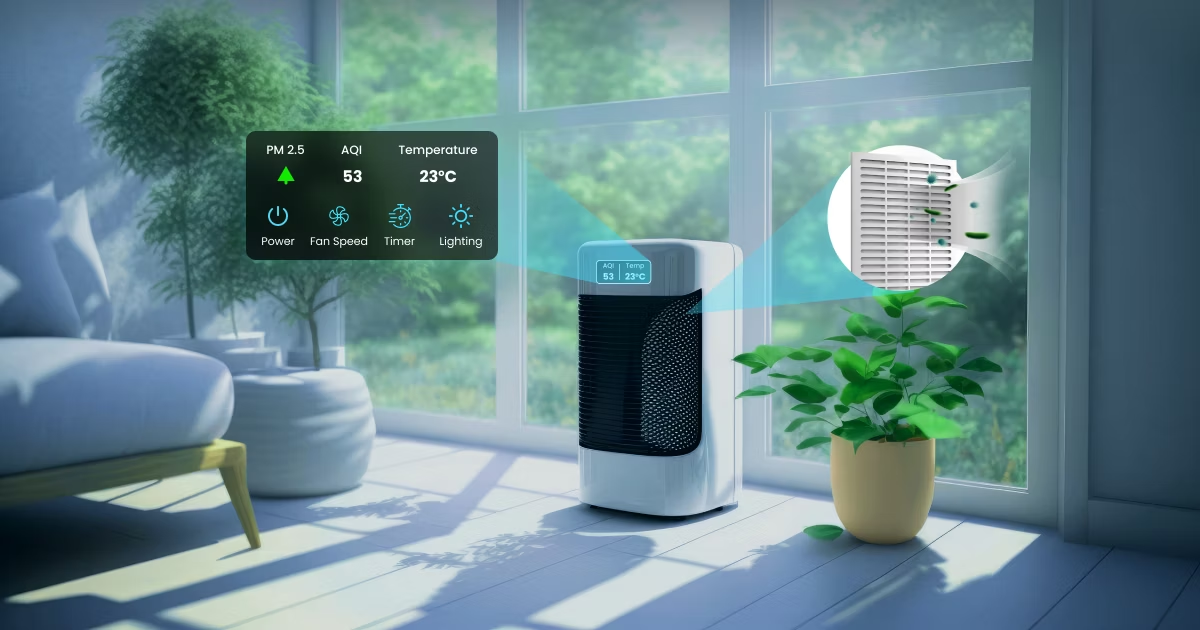In an era where air quality is increasingly compromised by pollution, allergens, and industrial emissions, air purification technology has become indispensable. These technologies, designed to cleanse the air of harmful particles, pollutants, and microorganisms, are crucial for maintaining healthy living environments, particularly in urban areas. Qivation.com company explores the best aspects of air purification technology, including its significance, types, benefits, challenges, and future trends.
Air quality has a profound impact on human health. Poor air quality can lead to a range of health issues, from respiratory problems like asthma and bronchitis to cardiovascular diseases and even cancer. Indoor air quality is particularly concerning, as people spend a significant amount of time indoors, where pollutants can accumulate. Air purification technology plays a vital role in mitigating these health risks by removing contaminants from the air, thus providing cleaner, healthier environments.
Types of Air Purification Technologies
HEPA Filtration
High-Efficiency Particulate Air (HEPA) filters are among the most common and effective air purification technologies. HEPA filters can capture particles as small as 0.3 microns with 99.97% efficiency, making them ideal for trapping dust, pollen, pet dander, and other airborne allergens. These filters are widely used in homes, hospitals, and industrial settings.
Activated Carbon Filters
Activated carbon filters are highly effective at removing odors, gases, and volatile organic compounds (VOCs) from the air. These filters use a process called adsorption, where pollutants adhere to the surface of the activated carbon. This technology is particularly useful in eliminating smoke, chemical fumes, and other gaseous pollutants.
UV Germicidal Irradiation
Ultraviolet (UV) germicidal irradiation uses UV-C light to kill or inactivate microorganisms such as bacteria, viruses, and mold spores. This technology is often used in conjunction with other air purification methods to enhance overall effectiveness. UV germicidal irradiation is widely used in healthcare settings to maintain sterile environments.
Ionizers and Electrostatic Precipitators
Ionizers release negatively charged ions into the air, which attach to airborne particles, causing them to clump together and fall out of the air. Electrostatic precipitators use an electric charge to remove particles from the air. These technologies are effective at removing fine particles and allergens but may produce ozone, a potential respiratory irritant.
Photocatalytic Oxidation
Photocatalytic oxidation (PCO) uses a catalyst, typically titanium dioxide, and UV light to create reactive hydroxyl radicals that break down pollutants at the molecular level. PCO is effective against a wide range of contaminants, including bacteria, viruses, VOCs, and odors. This technology is increasingly being incorporated into modern air purifiers.
Benefits of Air Purification Technology
Health Improvement
The primary benefit of air purification technology is the improvement of indoor air quality, leading to better health outcomes. By removing pollutants, allergens, and pathogens from the air, these technologies help reduce the incidence of respiratory and cardiovascular diseases, allergies, and infections.
Enhanced Comfort
Clean air contributes to a more comfortable living and working environment. Air purifiers can eliminate unpleasant odors, reduce dust accumulation, and create a fresher atmosphere, enhancing overall comfort and well-being.
Protection of Vulnerable Populations
Air purification is particularly beneficial for vulnerable populations, such as children, the elderly, and individuals with preexisting health conditions. These groups are more susceptible to the adverse effects of poor air quality, and air purifiers can significantly mitigate these risks.
Increased Productivity
Improved air quality has been linked to increased productivity and cognitive function. Cleaner air can reduce symptoms such as headaches, fatigue, and irritation, which are often caused by poor indoor air quality, thus enhancing overall performance in workplaces and educational settings.
Challenges in Air Purification Technology
Initial and Maintenance Costs
One of the main challenges associated with air purification technology is the cost. High-quality air purifiers can be expensive to purchase and maintain. Regular filter replacements and maintenance can add to the overall cost, making it a significant investment for some households and businesses.
Ozone Emission
Some air purification technologies, such as ionizers and ozone generators, can produce ozone as a byproduct. While ozone can be effective at removing certain pollutants, it is also a respiratory irritant and can be harmful to human health at high concentrations. This has led to concerns and regulatory scrutiny regarding the use of such technologies.
Limited Effectiveness Against Certain Pollutants
Not all air purifiers are equally effective against all types of pollutants. For instance, HEPA filters are excellent at capturing particulate matter but do not remove gases and odors. Activated carbon filters are effective against gases but may not capture fine particles. Combining multiple technologies can address this limitation but also increases complexity and cost.
Noise and Energy Consumption
Some air purifiers can be noisy and consume significant amounts of energy, which may be a concern for users looking for quiet and energy-efficient solutions. Advances in technology are addressing these issues, but they remain considerations for potential buyers.
Future Trends in Air Purification Technology
Smart Air Purifiers
The integration of smart technology into air purifiers is a growing trend. Smart air purifiers can be controlled remotely via smartphones, offer real-time air quality monitoring, and provide alerts when filters need replacement. These features enhance convenience and ensure optimal performance.
Integration with HVAC Systems
Integrating air purification technology with heating, ventilation, and air conditioning (HVAC) systems is becoming more common. This approach allows for whole-building air purification, ensuring consistent air quality throughout the space.
Sustainable and Eco-Friendly Designs
As awareness of environmental issues grows, there is an increasing demand for eco-friendly air purifiers. Manufacturers are focusing on using sustainable materials, reducing energy consumption, and designing recyclable filters to minimize environmental impact.
Advanced Filtration Materials
Research into advanced filtration materials, such as nanofibers and graphene, is paving the way for more efficient and effective air purifiers. These materials offer superior filtration capabilities and could revolutionize the air purification industry.
Conclusion
Air purification technology is essential in today’s world, where air quality is often compromised by pollution and other contaminants. By leveraging various technologies such as HEPA filtration, activated carbon, UV germicidal irradiation, ionizers, and photocatalytic oxidation, air purifiers play a crucial role in improving indoor air quality and protecting human health. Despite challenges such as cost and ozone emission, ongoing advancements and future trends promise to enhance the effectiveness, convenience, and sustainability of air purification solutions. As these technologies continue to evolve, they will undoubtedly become even more integral to maintaining healthy, comfortable living environments.



